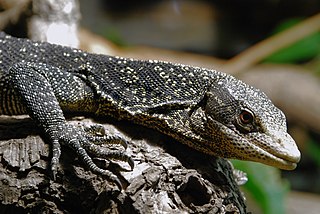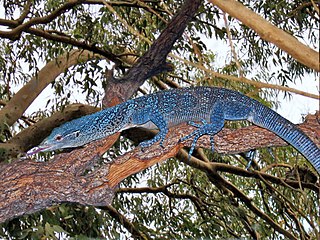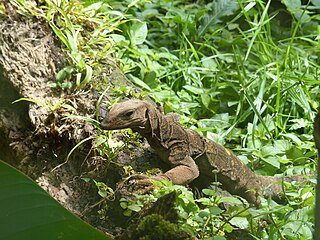
Monitor lizards are lizards in the genus Varanus, the only extant genus in the family Varanidae. They are native to Africa, Asia, and Oceania, and one species is also found in the Americas as an invasive species. About 80 species are recognized.

The black tree monitor or Beccari's monitor is a species of lizard in the family Varanidae. The species is a relatively small member of the family, growing to about 90–120 cm (35–47 in) in total length. V. beccarii is endemic to the Aru Islands off New Guinea, living in an arboreal habitat. The skin color of adults is completely black, to which one common name refers.

The mangrove monitor, mangrove goanna, or Western Pacific monitor lizard is a member of the monitor lizard family with a large distribution from northern Australia and New Guinea to the Moluccas and Solomon Islands. It grows to lengths of 3.5 to 4 ft. It is also known as wbl yb in the Kalam language of Papua New Guinea.

The emerald tree monitor or green tree monitor, is a small to medium-sized arboreal monitor lizard. It is known for its unusual coloration, which consists of shades from green to turquoise, topped with dark, transversedorsal banding. This coloration helps camouflage it in its arboreal habitat. Its color also makes the emerald tree monitor highly prized in both the pet trade and zoos alike.

The golden-spotted tree monitor, also known commonly as the golden speckled tree monitor, is a species of monitor lizard in the family Varanidae. The species is endemic to Waigeo Island in Indonesia.

The peach-throated monitor, also known as the Sepik monitor, is a species of monitor lizard native to New Guinea.

The turquoise monitor is a species of monitor lizards found in Indonesia. Specifically, it is found on Halmahera Island and in the Maluku Islands.

The Ceram mangrove monitor is a species of monitor lizards found in Indonesia. Specifically, it is found on some of the central Moluccan Islands including: Ambon, Seram, Obi, Buru, and Banda. On Ambon and probably on New Guinea V. cerambonensis occurs sympatrically with Varanus indicus. It is in the indicus species group of the subgenus Euprepiosaurus.

The blue-tailed monitor, blue-tailed tree monitor or Kalabeck's monitor, is a monitor lizard of the Varanidae family. It belongs to the V. doreanus group of the subgenus Euprepiosaurus.
Varanus keithhornei, commonly known as the canopy goanna, Keith Horne's monitor, blue-nosed tree monitor, or Nesbit River monitor, is a species of monitor lizards native to northeast Australia. It is a member of the Varanus prasinus species group.
The Rennell Island monitor is a species of monitor lizards found in the Solomon Islands archipelago. It is also known as the Hakoi Monitor. It belongs to the subgenus Euprepiosaurus along with the canopy goanna, the peach-throated monitor, Kalabeck's monitor, and others.

Varanus kordensis, the Biak tree monitor, is a member of the Varanidae family found on Biak Island in Indonesia. It is also known as the Kordo tree monitor. Long considered a subspecies of the emerald tree monitor, most authorities now treat it as a separate species.

Varanus macraei, the blue-spotted tree monitor or blue tree monitor, is a species of monitor lizard found on the island of Batanta in Indonesia. It is named after herpetologist Duncan R. MacRae, founder of the reptile park Rimba on Bali.
Varanus zugorum, also known commonly as the silver monitor or Zugs' monitor, is a species of monitor lizard in the family Varanidae. The species is endemic to the island of Halmahera in the Moluccas, in Indonesia.
Varanus rainerguentheri, also commonly known as Günther's mangrove monitor and Rainer Günther's monitor, is a species of lizard in the family Varanidae. The species is endemic to the Moluccas.

Varanus spinulosus, the Solomon Island spiny monitor, Isabel monitor, or spiny-neck monitor, is a species of monitor lizard. It is endemic to the Solomon Islands archipelago and is also known from Santa Isabel Island, San Jorge Island and Bourgainville Island.

Varanus reisingeri, known commonly as Reisinger's tree monitor and the Yellow tree monitor, is a species of monitor lizard in the family Varanidae. The species is endemic to Indonesia. It was at one point at least considered an allopatric insular subspecies of the green tree monitor, due to physical and genetic similarities.
Bogert's monitor is a species of tree-dwelling monitor lizard. The species is native to Papua New Guinea.
The Yuwono monitor or tricolor monitor, also commonly known as the black-backed mangrove monitor or the black-backed monitor, is a species of monitor lizard in the blue-tailed monitor species complex. The tricolor monitor is endemic to the island of Halmahera, in the Maluku Islands, Indonesia.

Hapturosaurus, sometimes known as the tree monitors, is a subgenus of lizards, consisting of slender-bodied arboreal monitor lizards mostly found in the tropical rainforests of Indonesia and Papua New Guinea.














